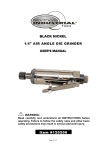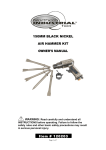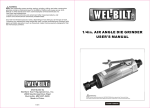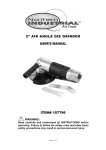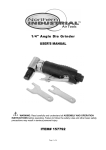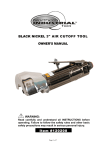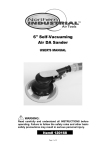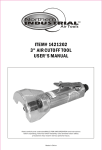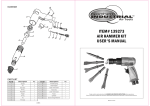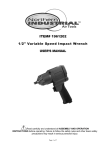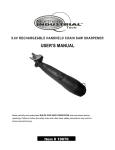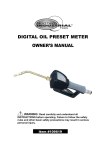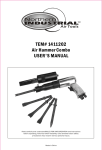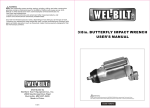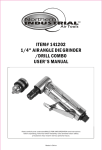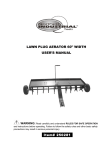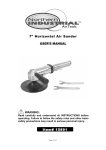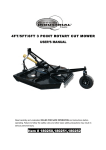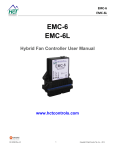Download 5in. HIGH SPEED AIR SANDER/DRILL COMBO USER`S MANUAL
Transcript
WARNING Some dust created by power sanding, sawing, grinding, drilling, and other construction activities contains chemicals known to the State of California to cause cancer, birth defects or other reproductive harm. Some examples of these chemicals are: lead from lead-based paints, crystalline silica from bricks and cement and other masonry products, and arsenic and chromium from chemically treated lumber. Your risk from these exposures varies, depending on how often you do this type of work. To reduce your exposure to these chemicals: work in a well-ventilated area, and work with approved safety equipment, such as those dust masks that are specially designed to filter out microscopic particles. 5in. HIGH SPEED AIR SANDER/DRILL COMBO USER'S MANUAL Distributed by Northern Tool + Equipment Co., Inc. 2800 Southcross Drive West Burnsville, MN 5337-0499 Made in China. 6 of 6 WARNING: Read carefully and understand all INSTRUCTIONS before operating. Failure to follow the safety rules and other basic safety precautions may result in serious personal injury. Item# 1991202 Note: To connect this tool, we recommend a quick coupler/adapter (not included). For smoother operation, put 3-5 drops of pneumatic tool oil in the Hose Joint (6) before each use. Step 1: Set the compressor's pressure regulator to 90 PSI. Do not set the compressor's outlet regulator over 90 PSI. Step 2: Connect the Sander/Drill to the air compressor's hose. If leaking is detected, disconnect the air hose and repair before use. DRILLING Step 1: Mark the material you wish to drill at the spot for the hole. Make sure your drill bit is the correct size for the hole you need to make. Step 2: If possible, clamp the material in a vise to make sure the material does not move or begin to spin while drilling. Step 3: Wear eye protection to guard against flying wood or metal. Step 4: Set the compressor's pressure regulator to 90 PSI. Do not set the compressor's outlet regulator over 90 PSI. Step 5: Connect the Sander/Drill to the air compressor's hose. If leaking is detected, disconnect the air hose and repair before use. Step 6: Grip the Sander/Drill firmly. Place the drill bit on the spot marked in Step 1. Step 7: To begin drilling, press the TRIGGER (10). Step 8: Your Sander/Drill has a variable speed for drilling. To vary the speed of the drilling action, vary the pressure on the TRIGGER. Step 9: Drill only as deep as necessary. Do not drill into walls or other areas where you cannot identify any possible hazards behind the drilling surface. Step 10: When you have drilled the hole, remove the drill bit from the hole while the Sander/Drill is still spinning. This is to prevent the drill getting caught in the hole and causing damage. For technical questions and replacement parts, please call 1-800-222-5381. Thank you very much for choosing a Wel-BiltTM, Product! For future reference, please complete the owner's record below: Model: _______________ Purchase Date: _______________ Save the receipt, warranty and these instructions. It is important that you read the entire manual to become familiar with this product before using it. This machine is designed for certain applications only. The distributor strongly recommends that this machine is not modified and/or used for any application other than that for which it was designed. If you have any questions relative to a particular application, DO NOT use the machine until you have first contacted Northern Tool + Equipment to determine if it can or should be performed on the product. Before using this product, please read the following instructions carefully. TECHNICAL SPECIFICATIONS Item Description Item Free Speed 18,000 RPM Air Inlet Diameter 1/4in.- 18NPT Chuck Type 3/8in. Jacobs Chuck Disc Size Air Consumption 3in., 4-1/2in., 5-1/2in. Max. Air Pressure 4 CFM Description R 90 PSI SAVE THIS MANUAL You will need this manual for the safety warnings and precautions, assembly, operating, inspection, maintenance and cleaning procedures, parts list and assembly diagram. Keep this manual and invoice in a safe and dry place for future reference. SAFETY RULES SANDING Step 1: Identify the area you will be sanding. Make sure you are using the appropriate grit sandpaper for the material you will be working with. Step 2: It is recommended that you start the Sander/Drill before placing the sandpaper disc onto the work surface. This will reduce deep scratching in the surface. Step 3: To operate the Sander/Drill, grip the BODY (1) with your palm and place pressure on the TRIGGER (10) to begin sanding. Step 4: You can vary the speed of the Sander/Drill to suit different sanding applications by varying the pressure placed on the TRIGGER. Step 5: It is recommended that you sand in a random pattern to avoid sanding a side to side into your work surface. Do not sand any one area too heavily, or for more than a few seconds at a time. Step 6: Every few minutes during continuous sanding, check the condition and wear of the sandpaper. If necessary, peel and replace the sandpaper. Do not use torn or severely worn sandpaper, you may damage your work surface or suffer physical injury. Step 7: When you are done sanding, remove the Sander/Drill from the work surface and release pressure on the TRIGGER to stop the Sander/Drill. Read all instructions before using this tool! 1.Keep work area clean. Cluttered areas invite injuries. 2.Observe work area conditions. Do not use machines or power tools in damp or wet locations. Don't expose to rain. Keep work area well lighted. Do not use electrically powered tools in the presence of flammable gases or liquids. 3.Keep pets, untrained operators and children away. Children must never be allowed in the work area. Do not let them handle machines, tools, or extension cords. 4.Store idle equipment. When not in use, tools must be stored in a dry location to inhibit rust. Always lock up tools and keep out of reach of children. 5.Use the right tool for the job. Do not attempt to force a small tool or attachment to do the work of a larger industrial tool. There are certain applications for which this tool was designed. It will do the job better and more safely at the rate for which it was intended. Do not modify this tool and do not use this tool for a purpose for which it was not intended. MAINTENANCE Your Sander/Drill is best operated with an Airline Oiler. If you are using the Sander/Drill without an Airline Oiler, follow the steps below for maintenance. Step 1: Disconnect the Sander/Drill from the air hose. Step 2: Apply a few drops of PNEUMATIC TOOL OIL through the air line before each use, or every hour if used continuously. Step 3: Apply a few drops of oil to the TRIGGER (10). Work the TRIGGER a few times to lubricate. 4 of 6 1 of 6 DIAGRAM & PART LIST Part# Description Qty. Part# Description 1 Body 1 17 Cylinder 1 2 Control Pin 1 18 Vanes 4 3 Rubber Gasket 1 19 Rotor 1 4 Ball 1 20 Bushing 1 5 Spring 1 21 Front End Plate 1 6 Hose Joint 1 22 Spacer 1 7 Rubber Gasket 1 23 Bearing 1 8 O-Ring 1 24 Cylinder Housing 1 9 Regulator 1 25 Sanding Adapter 1 10 Trigger 1 26 Holding Tool 1 11 Pin 1 27 Adapter Lock Down 1 12 Pin 1 28 Backing 3" Plate 1 13 Housing Lock Ring 1 29 Backing 4-1/2" Plate 1 14 Bearing 1 30 Backing 5-1/2" Plate 1 15 Spacer 1 31 Chuck 1 16 Rear End Plate 1 5 of 6 Qty. 6.Dress properly. Do not wear loose clothing or jewelry as they can be caught in moving parts. Protective, electrically non-conductive clothes and non-skid footwear are recommended when working. Wear restrictive hair covering to contain long hair. 7.Use eye protection. Always wear ANSI-approved impact safety goggles. Wear a full face shield if you are producing metal filings or wood chips. Wear an ANSI-approved dust mask or respirator when working around metal, wood, and chemical dusts and mists. 8.Do not overreach. Keep proper footing and balance at all times. Do not reach over or across running machines. 9.Maintain tools with care. Keep tools clean for better and safer performance. Follow instructions for changing accessories. Inspect tool periodically and if any part appears broken or damaged, have it repaired by an authorized technician. The handles must be kept clean, dry, and free from oil and grease at all times. 10.Disconnect power. Disconnect tool from air compressor when not in use and before changing accessories, maintaining, repairing, or cleaning. 11.Remove adjusting keys and wrenches. Check that adjusting wrenches are removed from the tool or machine work surface before connecting it to its power source. 12.Avoid unintentional starting. Be sure the air compressor switch is in the Off position when not in use and before connecting to this tool. Do not carry any tool with your finger on the trigger, whether it is connected or not. 13.Take caution as some woods contain preservatives such as copper chromium arsenate (CCA) which can be toxic. When cutting these materials extra care should be taken to avoid inhalation and minimize skin contact. 14.Check for damaged parts. Before using any tool, any part that appears damaged should be carefully checked to determine that it will operate properly and perform its intended function. Check for alignment and binding of moving parts; any broken parts; and any other condition that may affect proper operation. Any part that is damaged should be properly repaired or replaced by a qualified technician. Do not use the tool if the trigger does not operate properly. 15.Guard against electric shock. Prevent body contact with grounded surfaces such as pipes, radiators, ranges, and refrigerator enclosures. 16.Do not operate tool if under the influence of alcohol or drugs, or if you are tired. This may result in serious injury. 17.Use proper size and type extension cord. If an extension cord is required for the compressor, it must be of the proper size and type to supply the correct current to the tool without heating up. Otherwise, the extension cord could melt and catch fire, or cause electrical damage to the tool. 18.Maintenance. For your safety, service and maintenance should be performed regularly by a qualified technician. 19.Use clean, dry, regulated, compressed air at 90 PSI. Do not exceed the recommended 90 PSI. Never use oxygen, carbon dioxide, combustible gases, or any other bottled gas as a power source for this tool. Note: Performance of the compressor powering this tool (if powered by line voltage) may vary depending on variations in local line voltage. Extension cord usage may also affect compressor performance. ASSEMBLY DRILL BIT INSTALLATION Backing Plate CAUTION: Disconnect the Sander/Drill from the Air Supply prior to cleaning, maintaining, Adapter Lock Down or making any adjustments to The tool. Step 1: Thread the ADAPTER LOCK DOWN (27) counterclockwise to loosen it and remove the backing plate. Step 2: Thread the drill chuck onto the SANDING ADAPTER (25) Step 3: Open up the jaws of the drill by turning the CHUCK (31) counterclockwise as shown in Figure 2. Step 4: When the jaws are open wide enough to insert the drill bit (See Fig. 3), slide the bit into the CHUCK As far as possible. Step 5: By hand, turn the CHUCK to tighten the jaws. Step 6: Insert the Chuck Key into one of the three Chuck holes in the DRILL CHUCK, mating the teeth of the Chuck Key with the teeth of the DRILL CHUCK. Step 7: Turn the Chuck Key to tighten the jaws clockwise as shown in Fig. 4. Make sure the jaws are tight. Step 8: Put the Chuck Key in a safe place. Do not lose the Chuck Key. Fig 1 Fig 2 REMOVE THE CHUCK Step 1: Open the CHUCK (31) by turning the CHUCK counterclockwise. Insert the short end of a Hex Key Wrench into the CHUCK and tighten. Step 2: Place the HOLDING TOOL (26) into one of the two holes in the SANDING ADAPTER (25). See Fig. 5 Step 3: Turn the Hex Key Wrench counterclockwise to loosen the CHUCK. You may gently tap on the end of Holding Tool Fig 3 Fig 4 Hex Key Fig 5 the Hex Key Wrench with a rubber mallet (not included). Step 4: Remove the CHUCK. SANDER ASSEMBLY Disconnect the Sander/Drill from the Air Supply prior to cleaning, maintaining, or making any adjustments to the tool. Step 1: Tread the ADAPTER LOCK DOWN (27) clockwise to loosen it and remove out. Step 2: You will need sandpaper discs the appropriate size for the Backing Plate you will be using. Step 3: Place the desired BACKING PLATE (28, 29, or 30) over the threads of the ROTOR (19). Place the sandpaper disc over the BACKING PLATE. Step 4: Thread the ADAPTER LOCK DOWN (27) onto the ROTOR as shown in Figure 1. Tighten. 2 of 6 SET UP Fig. 6 3 of 6




